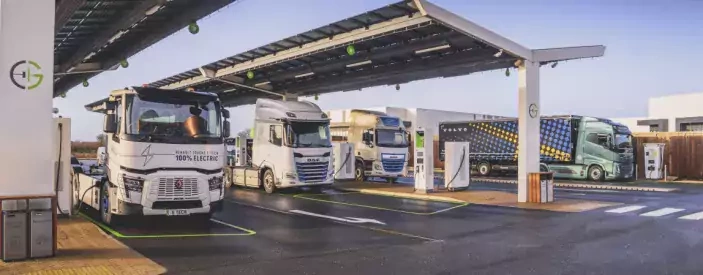Plotting a path for fully-electric commercial vehicles

It’s impossible to overstate the importance of the freight and logistics sector. According to statistics compiled by the Department for Transport (DfT), 1.6 billion tonnes of goods were lifted in the UK by HGVs between September 2022 and September 2023, covering 19.5 billion vehicle kilometres. And while transport may now be the UK’s largest sector emitter of CO2 emissions, one fifth of those emissions are attributed to HGVs.
Switching from predominantly diesel-powered trucks to battery electric HGVs is something we hope to accelerate via the Electric Freightway. Electric Freightway is part of the UK Government’s Zero Emission HGV and Infrastructure Demonstrator Programme, where the Department for Transport and Innovate UK provide special funding to projects that can ‘demonstrate’ how the UK can decarbonise HGVs in the shortest possible timeframes.
Switching from predominantly diesel-powered trucks to battery electric HGVs is something we hope to accelerate via the Electric Freightway. Electric Freightway is part of the UK Government’s Zero Emission HGV and Infrastructure Demonstrator Programme, where the Department for Transport and Innovate UK provide special funding to projects that can ‘demonstrate’ how the UK can decarbonise HGVs in the shortest possible timeframes.
Our plan, together with principal partner Hitachi Zero Carbon and 32 other consortium members from the freight and logistics industry, is to lay the foundations for the UK’s first nationwide network of electric or eHGVs.
Gridserve has plenty of experience when it comes to building award-winning charging infrastructure for electric cars, but electric trucks are a different ballgame. Not only do they require more space, but they also need significantly more power, with some of the latest eHGVs able to accept 1MW-capable charging – that’s the sort of power a small village consumes.
Hauliers and logistics companies traditionally work on low margins with purchasing decisions based on Total Cost of Ownership (TCO), so we’re acutely aware that making the switch for fleets can’t just be the green option; it needs to be the cheaper, more efficient option.
Hitachi Zero Carbon will help us build that data story, gathering telematics from our members’ c.140 vehicles that detail the routes, the consumption of energy and the charging behaviour. It will then marry this data to the type of vehicle that is in use, also monitoring the type of tractor unit, the type and weight of the trailer unit, even the type of tyre if known, so it can create the most accurate TCO model. Of course, due to ever-evolving factors like the price of diesel, the price of energy or even the battery performance of the next generation of trucks, TCO will continue to change and the algorithms will reflect this.
Understandably, business owners need proof, not only that today’s electric trucks have sufficient range and carrying capacities to do the job intended, but also that the EV charging infrastructure available is powerful, plentiful, reliable and fit for purpose. We’re confident that we’ll be able to prove over the duration of this project, let alone the duration of a vehicle’s working life, that eHGV charging infrastructure is a viable and fundamentally better experience and that the total cost of ownership for running an electric HGV fleet will be less expensive than an internal combustion engine equivalent.
You can stay updated on our progress by visiting gridserve.com/electric-freightway
Sam Clarke is Chief Vehicle Officer at GRIDSERVE

